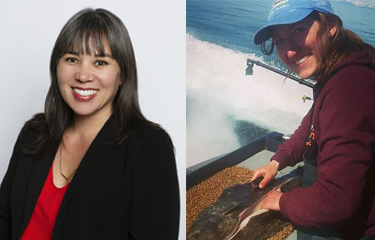Teresa Ish is the senior program officer and oceans initiative lead at the Walton Family Foundation and Marissa Wilson is the executive director of the Alaska Marine Conservation Council.
As climate change has increased its impact on our planet’s oceans, uncertainty has become the new normal. Warmer waters are causing fish to migrate to new environments to stay within their natural range, or to follow shifting sources of food. As the amount of carbon dioxide in our atmosphere rises, the ocean is becoming increasingly acidic, threatening the conditions necessary for all marine life to survive.
These changes are not only causing major disruptions to life within our oceans; they are also impacting the lives and livelihoods of people and communities who depend on healthy and sustainable marine ecosystems for food and commerce. In short, as the climate is changing, the laws and regulations that we use to protect both the fish in the ocean – as well as the fishers who rely on them – have to change as well.
Seafood matters locally, and beyond. Globally, more than 60 million people are employed by the seafood industry. In addition, more than three billion people around the world rely on fish for a significant source of protein.
Sustainable seafood is essentially fish that has been harvested from the ocean with a plan – which balances the needs of the ocean’s food chain, with those of the fishers and industry who count on fish for their livelihoods, as well as the growing population who are increasingly turning to seafood for a carbon-friendly source of protein.
The Magnuson-Stevens Act is the United States’ primary law governing fisheries conservation management since 1976 – and was last reauthorized more than 15 years ago. Stop and think for a moment how much we have learned and experienced in the last 15 years about climate change – it doesn’t take long to understand why there is urgency around updating this plan. Effective policy that works for both healthy fish populations – which are synonymous with healthy oceans – and the people who rely on them must include a vision for supporting robust, durable fisheries and resilient ecosystems based on abundant fish populations.
Additional considerations should include climate impacts on stocks, needs of both predators and prey, equity, and community and subsistence needs. As sea life migrates and ocean ecosystems shift, our data collection and integration are falling behind – and the rules and regulations we impose based on outmoded data are deeply flawed.
The challenge is real. While fishermen are known to characterize their work as being inherently unpredictable, saying “there’s a reason it’s not called catching,” the challenges that come with shifting stocks weave together economical, ecological, and social relations. Fortunately, real-time, place-based observations are something that fishermen are eager to gear up for and help provide. Through citizen science, data shortcomings and resulting uncertainties can be, and are being, mitigated and provide conservation-minded fishermen an important voice in management. Around the globe, ocean-dwellers are heightening their awareness of changes and are asking for fisheries managers to do the same.
In addition to citizen science, investments are needed in systems to collect high-quality data through electronic monitoring and electronic reporting and in the systems to manage the data collected.
It is critical that we update our regulations, preserve our oceans, and prepare for a very different future that will require a more nimble and responsive regulatory apparatus that can take into account our rapidly changing reality. And it will require better, more active coordination between international, national, regional, and local actors in order to respond quickly to the unprecedented movement of fish and other sea life.
The good news is that Congress is considering tools to address this challenge. Proposed legislation to reauthorize the Magnuson-Stevens bill includes important updates for responding to climate change, like expanding data collection efforts, improving timelines for rebuilding fish stocks, funding for disaster relief, and for mandating climate readiness assessments. In concert, these amendments will be essential for promoting sustainable and equitable fisheries.
Ultimately, though, a one-time fix is not enough. If we are going to address the future effectively, we must be able to adapt to the shifting reality and uncertainty of climate change as it occurs. That will mean keeping up with the changes we are already seeing, and being prepared to adjust our efforts on a much faster timeline. As we look ahead, we must continue to overhaul our approach to fish and fisheries in order to ensure sustainability and survival – of our sea life and those who rely on it, today and for decades to come.
Photos courtesy of Teresa Ish/Marissa Wilson






